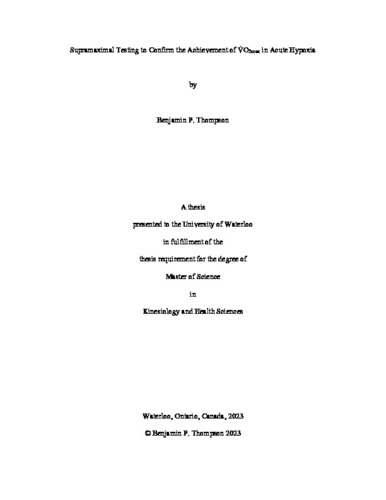| dc.contributor.author | Thompson, Benjamin | |
| dc.date.accessioned | 2023-01-23 18:23:45 (GMT) | |
| dc.date.available | 2023-01-23 18:23:45 (GMT) | |
| dc.date.issued | 2023-01-23 | |
| dc.date.submitted | 2022-12-15 | |
| dc.identifier.uri | http://hdl.handle.net/10012/19102 | |
| dc.description.abstract | Incremental exercise tests are often used to quantify an individual’s maximal oxygen uptake (V̇O2max). To confirm V̇O2max, a bout of supramaximal exercise can be performed after maximal exercise and if V̇O2 is within the measurement error (typically ~150 mL) one can presume a true V̇O2max was reached. Upon exposure to acute hypoxia, V̇O2max is known to decrease primarily due to decreases in convective oxygen transport. However, the decrease is variable between individuals, and it is unknown whether a supramaximal can similarly test if V̇O2max is achieved because the power output will still be lower than that of normoxia. Therefore, the purpose of this study was to determine if supramaximal exercise test confirms the achievement of V̇O2max in acute hypoxia. We hypothesized the incremental and supramaximal V̇O2 will be sufficiently similar in acute hypoxia. 20 healthy adults ( n = 7 female) completed incremental and supramaximal exercise tests in normoxia and acute hypoxia (FIO2 = 0.147) on separate days in a randomized order. The incremental exercise tests started at 80W & 60W for males and females in normoxia and 40W & 20W for males and females in hypoxia with a continuous increase of 20W/minute until volitional exhaustion. Following a 20min rest, the supramaximal test increased to 110% of peak power over 20 seconds and continued at constant power until volitional exhaustion. Cardiorespiratory variables were measured using a customized metabolic cart. Supramaximal exercise testing yielded a significantly lower V̇O2 than incremental testing in normoxia (3.87 ± 0.99 vs. 3.76 ± 0.92L/min) and hypoxia (3.27 ± 0.81 vs. 3.16 ± 0.78L/min). HR was significantly lower during the supramaximal test in normoxia (183 ± 7 vs. 176 ± 8bpm)
and hypoxia (182 ± 6 vs. 175 ± 6bpm). SpO2 was significantly higher in the hypoxic supramaximal test than incremental (82.2 ± 4.7 vs. 84.9 ± 4.1%) but not different in normoxia (94.7 ± 2.5 vs. 94.5 ± 4.8%). Equivalence testing indicated that supramaximal V̇O2 was not sufficiently similar to incremental testing in acute hypoxia. However, the mean difference in incremental and supramaximal V̇O2 in normoxic and acute hypoxic was less than 150mL/min, and physiologically speaking, should verify supramaximal exercise testing in acute hypoxia | en |
| dc.language.iso | en | en |
| dc.publisher | University of Waterloo | en |
| dc.subject | physiology | en |
| dc.subject | exercise | en |
| dc.subject | VO2max | en |
| dc.subject | supramaximal | en |
| dc.title | Supramaximal Testing to Confirm the Achievement of V̇O2max in Acute Hypoxia | en |
| dc.type | Master Thesis | en |
| dc.pending | false | |
| uws-etd.degree.department | Kinesiology and Health Sciences | en |
| uws-etd.degree.discipline | Kinesiology | en |
| uws-etd.degree.grantor | University of Waterloo | en |
| uws-etd.degree | Master of Science | en |
| uws-etd.embargo.terms | 0 | en |
| uws.contributor.advisor | Dominelli, Paolo | |
| uws.contributor.affiliation1 | Faculty of Health | en |
| uws.published.city | Waterloo | en |
| uws.published.country | Canada | en |
| uws.published.province | Ontario | en |
| uws.typeOfResource | Text | en |
| uws.peerReviewStatus | Unreviewed | en |
| uws.scholarLevel | Graduate | en |

